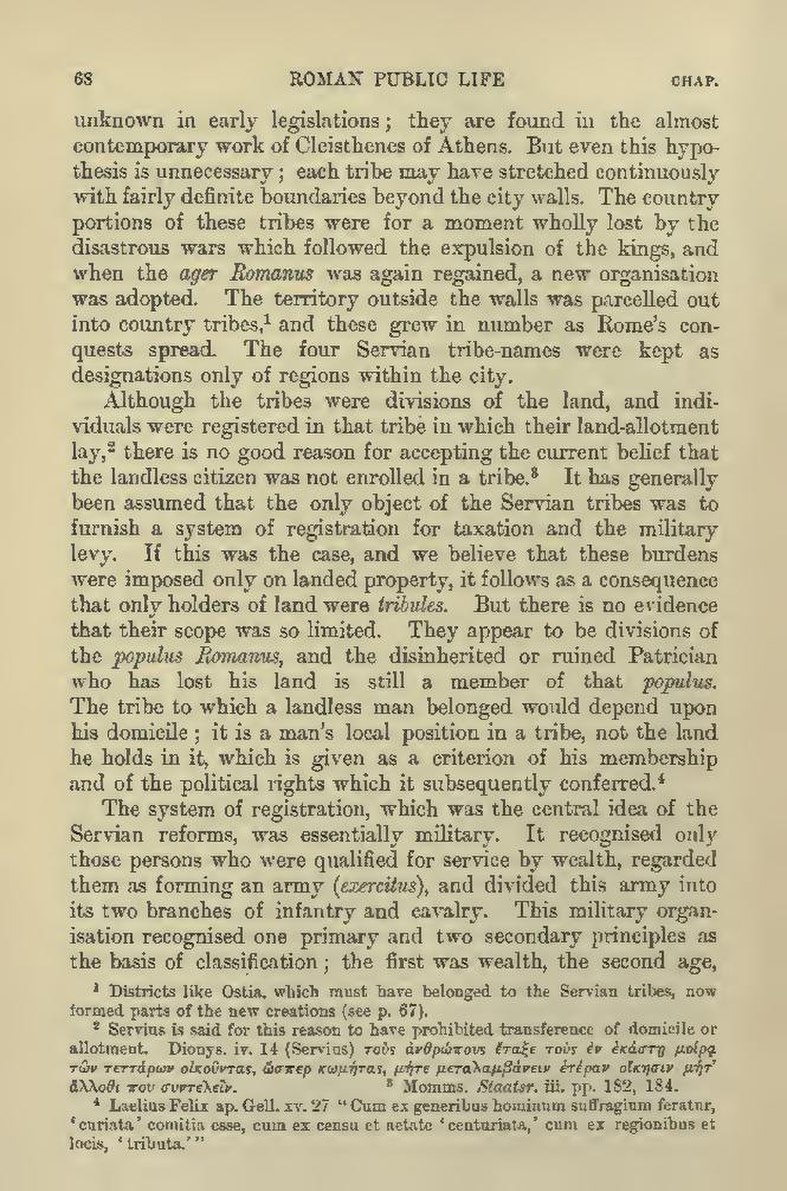unknown in early legislations; they are found in the almost contemporary work of Cleisthenes of Athens. But even this hypothesis is unnecessary; each tribe may have stretched continuously with fairly definite boundaries beyond the city walls. The country portions of these tribes were for a moment wholly lost by the disastrous wars which followed the expulsion of the kings, and when the ager Romanus was again regained, a new organisation was adopted The territory outside the walls was parcelled out into country tribes,[1] and these grew in number as Rome's conquests spread. The four Servian tribe-names were kept as designations only of regions within the city.
Although the tribes were divisions of the land, and individuals were registered in that tribe in which their land-allotment lay,[2] there is no good reason for accepting the current belief that the landless citizen was not enrolled in a tribe.[3] It has generally been assumed that the only object of the Servian tribes was to furnish a system of registration for taxation and the military levy. If this was the case, and we believe that these burdens were imposed only on landed property, it follows as a consequence that only holders of land were tribules. But there is no evidence that their scope was so limited. They appear to be divisions of the populus Romanus, and the disinherited or ruined Patrician who has lost his land is still a member of that populus. The tribe to which a landless man belonged would depend upon his domicile; it is a man's local position in a tribe, not the land he holds in it, which is given as a criterion of his membership and of the political rights which it subsequently conferred.[4]
The system of registration, which was the central idea of the Servian reforms, was essentially military. It recognised only those persons who were qualified for service by wealth, regarded them as forming an army (exercitus), and divided this army into its two branches of infantry and cavalry. This military organisation recognised one primary and two secondary principles as the basis of classification; the first was wealth, the second age,.]
- ↑ Districts like Ostia, which must have belonged to the Servian tribes, now formed parts of the new creations (see p. 67).
- ↑ Servius is said for this reason to have prohibited transference of domicile or allotment. Dionys. iv. 14 (Servius) [Greek: tous anthrôpous etaxe tous en hekastê moira tôn tettarôn oikountas, hôsper kômêtas, mête metalambanein heteran oikêsin mêt' allothi pou syntelein
- ↑ Momms. Staatsr. iii. pp. 182, 184.
- ↑ Laelius Felix ap. Gell. xv. 27 "Cum ex generibus hominum suffragium feratur, 'curiata' comitia esse, cum ex censu et aetate 'centuriata,' cum ex regionibus et locis, 'tributa.'"
